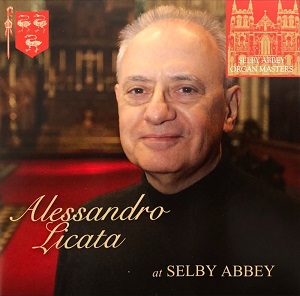
Alessandro Licata (organ)
At Selby Abbey
Johann Sebastian Bach (1685-1750)
Prelude in E-flat, BWV 552 (1739)
Girolamo Frescobaldi (1583 -1643)
Toccata I (from II Book)
Antonio Vivaldi (1678-1741)
Concerto in A minor, Op 3 No 8
Transcribed for organ by Johann Sebastian Bach, BWV 593
Alfredo Luigi Cornacchia (born 1972)
Le Baptême de la Solitude
Johann Sebastian Bach
Fugue in E-flat, BWV 552 (1739)
rec. 2022, Selby Abbey, Selby, UK
Selby Abbey Organ Masters SAOM014 [52]
For those of us of a certain age, Selby Abbey and its famous Hill organ is inextricably linked with the name of Fernando Germani who made a notable series of recordings there during the 1960s, which have recently been released on CD. Alessandro Licata was Germani’s pupil from 1965 to 1974 and in his own words, ‘follow(s) his example playing Frescobaldi, as he did, and Bach too, on the Abbey’s English Romantic organ…’ I have found the results somewhat surprising. The Frescobaldi Toccata sounds very convincing, with suitably limpid registration and clarity of articulation. The opening Prelude in E flat, BWV 552, however, seemed less successful. Professor Licata chose not to attempt to reproduce the classical registration and I was surprised by the preponderance of reed tone, both on the manuals and pedals, combined with a tempo which seemed lacking in forward momentum. Whether this was designed to accommodate the acoustics of the building is difficult to say, but the musical result was unsatisfying. The same problem was apparent in the outer movements of the Concerto after Vivaldi BWV 593, although here the registration seemed more characteristic of the period of the music.
The contemporary piece included in the programme, Le Baptême de la Solitude by Alfredo Luigi Cornacchia, is perhaps the most striking piece in what is a somewhat short recital. Ian Wells in his note gives an accurate description of the work, which after a quiet and contemplative beginning, increases in intensity in a manner which suggests a search for some kind of metaphysical goal, but the close seemed somewhat inconclusive.
Taken as a whole, this an unsatisfying disc; the Baroque items seem to suggest a rather old-fashioned approach and there were opportunities for more variety of tone colour, even on what is a romantic instrument. The work by Alfredo Luigi Cornacchia is interesting, partly because the listener is given the chance to hear some of the many quiet tone colours available. I would be interested to hear the same player in other repertoire, perhaps more contemporary with the instrument.
Martyn Strachan
Availability: Jonathan Wearn, Producer

















